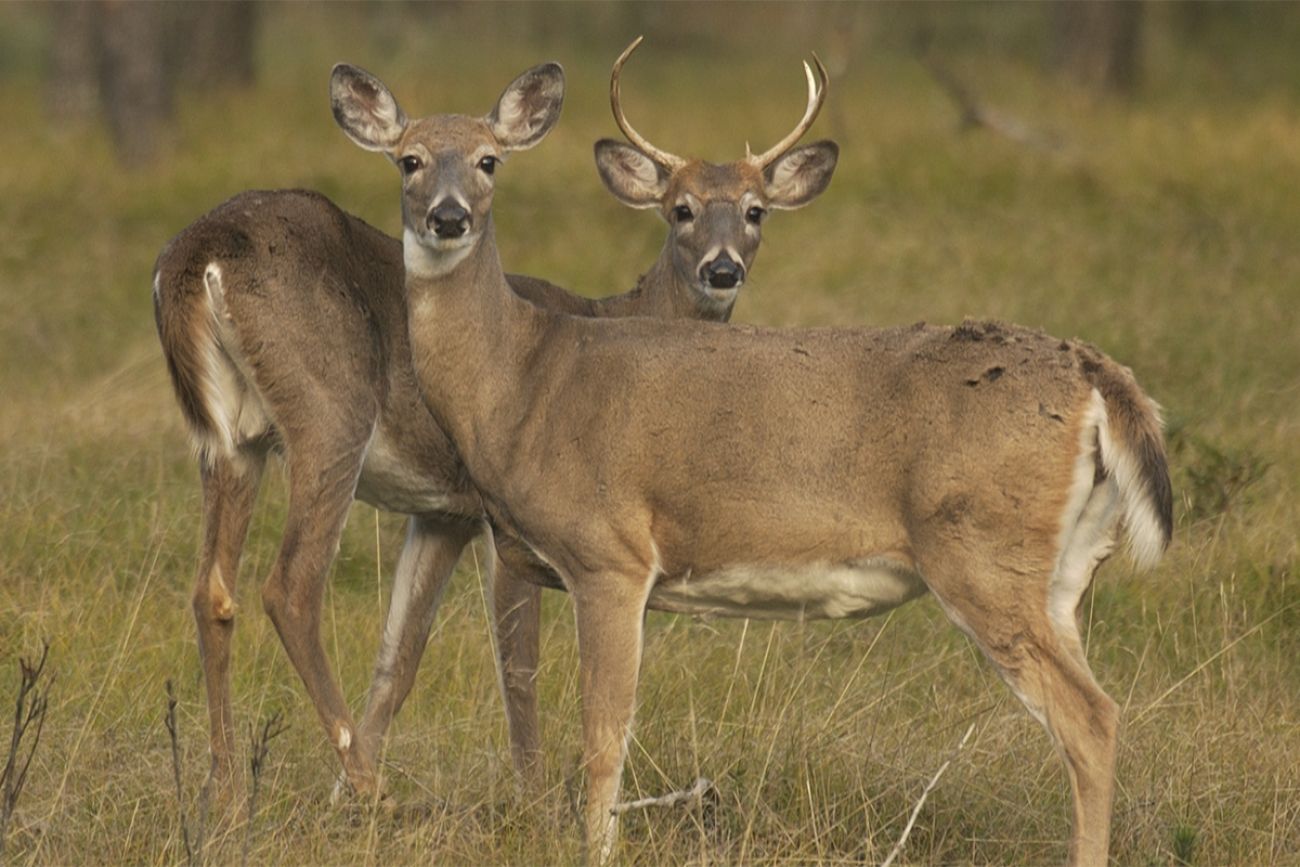Michigan approves new deer hunting regulations to address overpopulation

- Michigan’s Natural Resources Commission adopted new deer hunting regulations for the upcoming season
- The changes come as Michigan’s deer hunting population has declined significantly over the last several years
- The decline in hunters has resulted in an increase in the deer population across the state
The Michigan Natural Resources Commission on Thursday approved new deer hunting regulations to address the overpopulation of deer but the Department of Natural Resources and some hunters think the state can go further.
While the commission adopted some of the proposals that grew out of the state’s Deer Management Initiative, such as extending the archery hunting season for antlerless deer, some of the most anticipated changes — like an antler point restriction in the Lower Peninsula, a one-buck limit in the L.P. and reversing the ban on baiting in some areas across the state — failed to win approval.
The DNR created the Deer Management Initiative earlier this year. It’s composed of two focus groups — one in each peninsula — made up of hunters, farmers and conservationists.
Michigan’s deer herd has been estimated at 2 million, its growth driven largely by a decline in the number of hunters. The population expansion has been more pronounced in the southern Lower Peninsula.
The excessive number of deer negatively impacts farmers and their crops — deer can eat up to 8 pounds of vegetation each day. It also impacts drivers. In 2022, there were over 58,000 deer-related car accidents in Michigan, according to the state’s most recent data.
Related:
- Michigan reports worst outbreak of viral disease in wild deer in 12 years
- Five reasons why Michigan deer herds are surging: hunting declines are just one
- Michigan officials propose changes to deer hunting regulations
- Change Michigan’s Nov. 15 deer season opener? No way, DNR says
- Hunting season in Michigan: What to know about licenses, seasons, limits
Among the newly adopted regulations in the Lower Peninsula are limiting the liberty and independence hunts, reserved for those 16 years or younger or hunters with disabilities, to antlerless deer beginning in 2025. Previously, a deer license or a combination license to hunt antlered or antlerless deer was allowed.
“The problem is, the doe population in southern Michigan is … out of control. We're shooting too many bucks and not enough does,” said Chad Timmer, owner of The Outdoorsmen Pro Shop in Jenison, south of Grand Rapids.
“We have a doe population problem and we need to deal with it. If we could go to a one-buck state, in just a handful of years, we would revolutionize the quality deer herd in Michigan,” Timmer said.
In Michigan, hunters can kill up to 12 deer with a combination license and 10 universal licenses. Theoretically, a hunter could kill two bucks and 10 does. Many hunters pass up shooting does and prefer bucks which are larger and meatier. However, Timmer believes hunters should be limited to one buck as a compromise: hunters can enjoy a “trophy kill” while still leaving enough bucks to reproduce.
The Commission also approved an extension to the archery season for antlerless deer through Jan. 31 in Huron, Kent, Lapeer, Sanilac, Tuscola, and St. Clair counties — excluding islands in the St. Clair Flats — and Washtenaw County. Previously, archery season in the Lower Peninsula was Oct. 1 - Nov. 14 and Dec. 1 - Jan. 1.
A new antlerless deer season beginning Jan.2 through the second Sunday of the month was also approved for several counties in lower Michigan. The new regulation applies in Bay, Midland, Newaygo, Macomb, Oakland, Livingston, Calhoun and Monroe counties along with several others.
Not far enough?
While some within the hunting community believe targeting does may help adjust the population, Chad Stewart, deer management specialist for the DNR said simply extending hunting opportunities may not provide significant changes.
“There's the two schools of thought: one is to protect every doe because they're the ones that get and have fawns,” Stewart said. “The other group is saying … you can support as many deer as you can, and you've got already these very skewed and imbalanced sex ratios, and that's contributing to the problem. So we actually need to try to realign things,” he added.
The Commission did adopt one of the Deer Management Initiative’s recommendations to expand early and late firearm season for antlerless deer to public and private lands, as opposed to just private lands.
“Typically, when you continue to add on something that is already fairly saturated, you really get diminishing returns from it,” Stewart said. “They (hunters) already have 90 and sometimes even more days to go out and hunt.”
Managing the deer population in the Upper Peninsula presents a different challenge. The combination of the diverse predator population including bears, wolves and coyotes, and changing climate conditions has resulted in overall less deer in the region, Stewart said.
“Our obligation as natural resources commissioners is simple, and that is to work toward and strive for a healthy herd, no matter what the species is,” said Commissioner John W. Walters. “And right now, the whitetail deer population in the state of Michigan is not healthy because of the out-of-balance deer population, in especially the Lower Peninsula, and then the lack of deer in the Upper Peninsula.”
The commission strengthened restrictions in the Upper Peninsula, decreasing the number of antlerless hunting licenses issued, from 1,000 to 0 in Deer Management Unit 351, in parts of the eastern U.P. and from 1,000 to 500 DMU 352 which includes parts of the western U.P., to protect the doe population and allow bucks to mate.
Population challenge
Efforts from the DNR to loosen regulations for deer hunting have had little effect on the number of deer harvested each year, which has decreased over the past decade.
In 2023, 274,299 deer were harvested in Michigan compared to 303,055 in 2022, according to the DNR’s harvest report.
The proposed changes by the department’s Commission come as the state is looking for new ways to attract more residents to the sport as the number of hunters in the state has significantly decreased over the past several years.
The DNR estimates that 527,000 deer hunters took to the field in 2023, and 516,000 in 2022. About a decade ago, in 2013, 662,000 deer hunters were afield and in 2003 it is estimated that there were 743,000 deer hunters that season.
Michigan hunters are aging out of the sport but new hunters are not replacing them, which is the main cause of the state's excessive deer population, which can be a nuisance to residents.
“I hunt out of state, and I spend tens of thousands of dollars doing so, and I would be happy to spend that money in Michigan,” said Timmer, Michigan business owner. “We have a different culture here than they do, a different way we approach hunting in Michigan than they do in other states.”
Michigan Environment Watch
Michigan Environment Watch examines how public policy, industry, and other factors interact with the state’s trove of natural resources.
- See full coverage
- Subscribe
- Share tips and questions with Bridge environment reporter Kelly House
Michigan Environment Watch is made possible by generous financial support from:
Our generous Environment Watch underwriters encourage Bridge Michigan readers to also support civic journalism by becoming Bridge members. Please consider joining today.
See what new members are saying about why they donated to Bridge Michigan:
- “In order for this information to be accurate and unbiased it must be underwritten by its readers, not by special interests.” - Larry S.
- “Not many other media sources report on the topics Bridge does.” - Susan B.
- “Your journalism is outstanding and rare these days.” - Mark S.
If you want to ensure the future of nonpartisan, nonprofit Michigan journalism, please become a member today. You, too, will be asked why you donated and maybe we'll feature your quote next time!






